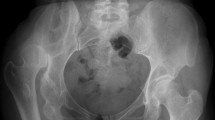Abstract
Introduction
Total joint replacement in patients suffering from developmental dysplasia of the hip poses specific technical difficulties due to insufficient bone stock at the site of the original and secondary acetabulum and a narrow, cranially displaced proximal femur.
Materials and methods
Twelve hips with severe congenital dislocation (4 Crowe type II, 5 type III, 3 type IV) were treated with cementless, porous structured total hip replacement. The cup was implanted at the anatomic height, a femoral segment was resected below the minor trochanter to reduce the femoral component in all cases.
Results
One femoral component was exchanged for a longer stem after 2 months due to insufficient fit and fill. After a mean follow-up of 5.1 years, there were no further revisions or radiographic signs of loosening. No cup was revised or loose radiographically. Harris hip score (mean) improved from 36 to 82 points, mean leg length discrepancy was reduced from 5.4 to 1.3 cm.
Conclusion
The cementless technique described is useful in cases of severe congenital dislocation of the hip when the cup is implanted at the anatomic level, and implant reduction is not possible despite thorough soft-tissue release or not advisable because of excessive limb lengthening. A reconstruction of the original joint center and good mid-term results are demonstrated.





Similar content being viewed by others
References
Anderson MJ, Harris WH (1999) Total hip arthroplasty with insertion of the acetabular component without cement in hips with total congenital dislocation or marked congenital dysplasia. J Bone Joint Surg Am 81:347–354
Anwar MM, Sugano N, Masuhara K, Kadowaki T, Takaoka K, Ono K (1993) Total hip arthroplasty in the neglected congenital dislocation of the hip. A five- to 14-year follow-up study. Clin Orthop 295:127–134
Chareancholvanich K, Becker DA, Gustilo RB (1999) Treatment of congenital dislocated hip by arthroplasty with femoral shortening. Clin Orthop 360:127–135
Crowe JF, Mani VJ, Ranawat CS (1979) Total hip replacement in congenital dislocation and dysplasia of the hip. J Bone Joint Surg Am 61:15–23
Daniels L, Worthingham C (1985) Muskelfunktionspruefung, manuelle Untersuchungstechniken. Fischer, Stuttgart
DeLee JG, Charnley J (1976) Radiological demarcation of cemented sockets in total hip replacement. Clin Orthop 121:20–32
Dorr LD, Tawakkol S, Moorthy M, Long W, Wan Z (1999) Medial protrusio technique for placement of a porous-coated, hemispherical acetabular component without cement in a total hip arthroplasty in patients who have acetabular dysplasia. J Bone Joint Surg Am 81:83–92
Edwards BN, Tullos HS, Noble PC (1987) Contributory factors and etiology of sciatic nerve palsy in total hip arthroplasty. Clin Orthop 218:136–141
Eftekhar NS (1993) Variations in technique and specific considerations. In: Eftekhar NS (ed) Principles of total hip arthroplasty. Mosby, St. Louis, pp 925–967
Eggli S, Hankemayer S, Muller ME (1999) Nerve palsy after leg lengthening in total replacement arthroplasty for developmental dysplasia of the hip. J Bone Joint Surg Br 81:843–845
Engh CA, Bobyn JD, Glassman AH (1987) Porous coated hip replacement. The factors governing bone ingrowth, stress shielding, and clinical results. J Bone Joint Surg Br 69:45–55
Gruen TA, McNeice GM, Amstutz HM (1979) Modes of failure of cemented stem-type femoral components. A radiographic analysis of loosening. Clin Orthop 141:17–27
Harris WH (1969) Traumatic arthritis of the hip after dislocation and acetabular fractures: Treatment by mold arthroplasty. J Bone Joint Surg Am 51:737–755
Harris WH (1998) Total hip arthroplasty in the management of congenital hip dislocation. In: Callaghan JJ, Rosenberg AG, Rubash HE (eds) The adult hip. Lipincott-Raven, Philadelphia, pp 1165–1182
Heekin RD, Callaghan JJ, Hopkinson WJ, Savory CG, Xenos JS (1993) The porous coated anatomic total hip prosthesis, inserted without cement. J Bone Joint Surg Am 75:77–91
Holtgrewe JL, Hungerford DS (1989) Primary and revision total hip replacement without cement and with associated femoral osteotomy. J Bone Joint Surg Am 71:1487–1495
Malchau H, Karrholm J, Wang YX, Herberts P (1995) Accuracy of migration analysis in hip arthroplasty. Digitized and conventional radiography, compared to radiostereometry in 51 patients. Acta Orthop Scand 66:418–424
Mendes DG (1981) Total hip arthroplasty in congenital dislocated hips. Clin Orthop 161:163–179
Paavilainen T (1997) Total hip replacement for developmental dysplasia of the hip. Acta Orthop Scand 68:77–84
Pagnano W, Hanssen AD, Lewallen DG, Shaughnessy WJ (1996) The effect of superior placement of the acetabular component on the rate of loosening after total hip arthroplasty. J Bone Joint Surg Am 78:1004–1014
Ranawat CS, Dorr LD, Inglis AE (1980) Total hip arthroplasty in protrusio acetabuli of rheumatoid arthritis. J Bone Joint Surg Am 78:1059–1064
Robertson DD, Essinger JR, Imura S, Kuroki Y, Sakamaki T, Shimizu T, Tanaka S (1996) Femoral deformity in adults with developmental hip dysplasia. Clin Orthop 327:196–206
Schmalzried TP, Amstutz HC, Dorey FJ (1991) Nerve palsy associated with total hip replacement. Risk factors and prognosis. J Bone Joint Surg Am 73:1074–1080
Shinar AA, Harris WH (1997) Bulk structural autogenous grafts and allografts for reconstruction of the acetabulum in total hip arthroplasty. Sixteen-year-average follow- up. J Bone Joint Surg Am 79:159–168
Stans AA, Pagnano MW, Shaughnessy WJ, Hanssen AD (1998) Results of total hip arthroplasty for Crowe Type III developmental hip dysplasia. Clin Orthop 348:149–157
Sugano N, Noble PC, Kamaric E, Salama JK, Ochi T, Tullos HS (1998) The morphology of the femur in developmental dysplasia of the hip. J Bone Joint Surg Br 80:711–719
Verdonshot N (1995) Biomechanical failure scenarios for cemented total hip replacement (PhD thesis). Catholic University of Nijmegen, Nijmegen
Author information
Authors and Affiliations
Corresponding author
Rights and permissions
About this article
Cite this article
Decking, J., Decking, R., Schoellner, C. et al. Cementless total hip replacement with subtrochanteric femoral shortening for severe developmental dysplasia of the hip. Arch Orthop Trauma Surg 123, 357–362 (2003). https://doi.org/10.1007/s00402-003-0554-4
Received:
Published:
Issue Date:
DOI: https://doi.org/10.1007/s00402-003-0554-4




